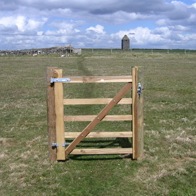-
The post below is the beginning of a paper I wrote a few years ago exploring the roots of organizational engagement. The paper makes the claim that deep engagement involves a stance of radical opennenss – openness to everyone and to everything within everyone. The claim is absurd, of course. It is also, I think, true.
In the full paper I describe this kind of open stance in terms of two qualities: oneness and fullness. I argue that, though we can see the motion toward oneness and fullness in many different strands of spiritual inquiry and social critique, our traditional approaches to organizational architecture restrain us from invoking that motion. I then explore a different kind of “unbound” architecture that can, I believe, foster the real and sustained human engagement we seek – the sort of engagement that, were it widespread enough, could rewrite the world in ways far beyond our current capacites for social imagination.
—
There is no outside, no inclosing wall, no circumference to us.
– Emerson
My father-in-law, Jim, is a great destroyer of walls. Every house he has lived in will bear me out. Each is filled with reclaimed open space, the air laced with the cheerful scars of what has been removed. To create such space, a man needs to have a strong desire to see the world – the whole thing – from the chair where he sits.
He also needs a hammer.
Once, eating breakfast in his underwear, it occurred to Jim that the wall between the kitchen and the dining room was an extravagance. He put down his spoon, took a hammer from a drawer, and swung without comment, tearing off random patterns of sheetrock. He didn’t take the entire wall down – he had the weekend for that – just marked it enough to remind everyone that here was where a wall ought not to be. The children ate their cereal, unappalled.
Jim uses a gentler hammer with people. He is drawn to searching for connections where the rest of us see only boundaries. A difficult family member or guest makes him curious, not anxious. And his conversations with even the most strident or hostile people are unguarded. To talk with Jim is to wander. And in the wandering he will find and gather things that you do not. He will find them because he looks for them. And he will gather them because he wears the right boots.
Perhaps Jim is like this because he is a landscape architect. He is used to a certain way of walking and a certain way of seeing, after all. He is highly trained. But it might also be a matter of faith. Maybe Jim is simply the kind of man who never sees a wall that he believes in or a field that he doesn’t.
The Sociology of the Possible
This paper is about organizational boundaries, the seemingly sensible divisions we make between one thing and another, or one person and another, as we pursue our organizational aims. We rely on boundaries for structure and coherence. We rely on them for meaning. The boundary seems to be the basic geometrical ground of organization, the structural dynamic that allows any organization to exist in the first place. I will explore the consequences of this geometry in terms of its confounding effect on human engagement. And I will consider the possibility that there is another kind of geometry, an unbound geometry that nurtures the human spirit while maintaining a profound and useful organizing power of its own.
This paper is also about organizational faith. The theologian Paul Tillich describes faith as the “dynamics of ultimate concern” (1957). He sees faith not as a particular set of beliefs but as a stance toward the world, a determination to engage with the things that matter most however one names those things or wherever one finds them. Faith, in this sense, is engagement. And there is a long-echoing complaint in the literature of industrial critique that it is precisely this kind of engagement that organizations lack. We do not find organizational life deeply engaging, because organizational spaces are not built in such a way as to connect us with what we most care about. If this complaint is true, and I think it is, it is a particularly troubling one in an age that relies on organizations to frame, provoke, and embody larger patterns of social and institutional change. If something in an organization’s DNA prevents it from pursuing ultimate meanings, we are unlikely to see such meanings blossom in the broader social world. At times, then, (especially in the latter part of the paper) my arguments will seem targeted toward social change organizations – those organizations that concern themselves explicitly with social meanings. But ultimately I think every organization is a social change organization. Every organization creates or recreates the relationship patterns that thicken into cultures and institutions – the patterns that we have come to think of as society.
Three questions, then, are at the heart of this paper:
What can we say about the fundamental dynamics of human engagement?
What are the conditions that allow such engagement to flourish in organizational settings?
What is the relationship between organizational engagement and broader patterns of social purpose or meaning?
I will argue that the answers to these questions have everything to do with the ways in which we create, maintain, and rely upon boundaries as the structural and ideological ground of organizational life.
This is largely a theoretical paper. Much of its framework will be presented deductively. But I confess that I originally arrived at many of these ideas inductively by working in the field with a small number of extraordinary organizations. I will draw upon two of these organizations in particular. They will serve as examples, helping to clarify the themes I explore. They will also, I hope, infuse the paper with a sense of possibility – even plausibility – that is at least somewhat earned. Ultimately, I am less concerned with describing how the world works than with describing how the world could work given who we are and what we know about the nature of social structuring. The sociology at work here is not the sociology of the given, but the sociology of the possible. The organizations that have helped form the ideas in this paper are organizations that teach us what we might be.
Click here to read the full paper Organization Unbound: The Spiritual Architecture of Organizations.
Invoking Jim




